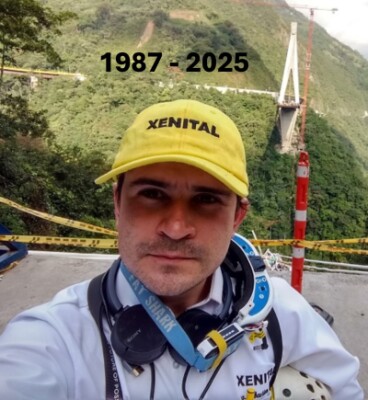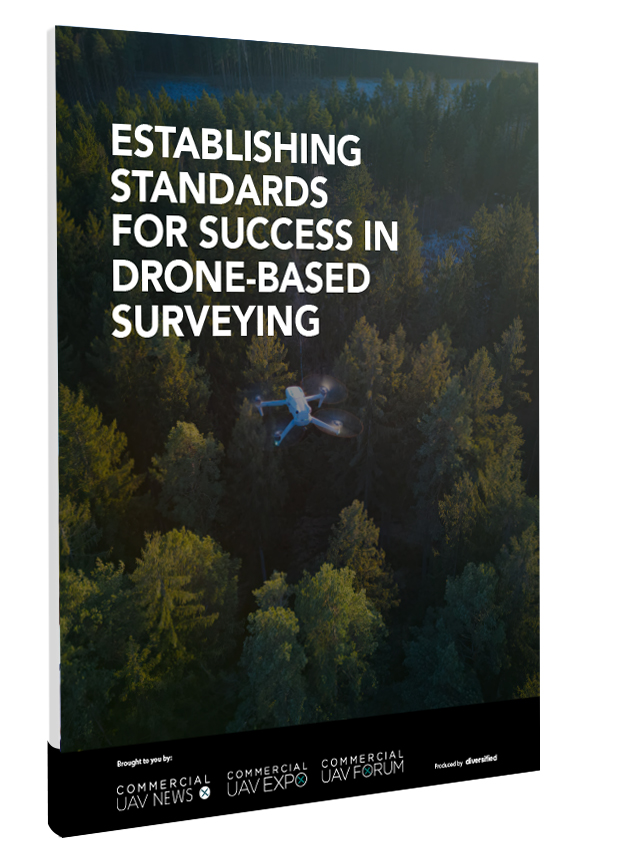Our first day covering AUVSI’s XPONENTIAL event saw us focus on precision agriculture and mining, while Day 2 saw us looking at some developments in oil and gas and search and rescue.
On Day 3, our perspective was pulled further back to look at the industry as a whole, as FAA Administrator Michael Huerta was the main event at the general session that started the day. We kept up with that focus on industry wide topics with a look at BVLOS developments and how women are making an impact in the industry, but still had time to take a look at how drones are changing the way things are done on construction sites.Keep checking back with us for a final update from XPONENTIAL.
Administrator Huerta (left) and XPONENTIAL host Miles O'Brien
 Drones on Site: Business Cases for the Construction Industry showcased the multiple ways drones have been used in construction, and how they’re changing the approach of professionals. Dick Zhang, Gary Bullock, John Babel and William Baker were on stage to deliver an informal presentation and discussion which refreshingly didn’t contain any slides and featured great interactions with the audience.The panelists laid out what can be done with drones in this industry in terms of applications and capabilities. The desire and need to automate processes was discussed, and also what controls can and should be put in place. They laid out how and why drones are extending the capabilities of people to do something better.Babel is a risk engineering professional, and how such considerations impact construction projects as a whole was something the group got into. Liability was also mentioned, especially when it came to automation, because it’s one thing for a person to make a mistake. Those mistakes can be forgiven in a way machines cannot, and one major issue with a machine could spell the end of an entire program. Most managers are aware of these stakes, which is why they’re extra cautious around implementation.
Drones on Site: Business Cases for the Construction Industry showcased the multiple ways drones have been used in construction, and how they’re changing the approach of professionals. Dick Zhang, Gary Bullock, John Babel and William Baker were on stage to deliver an informal presentation and discussion which refreshingly didn’t contain any slides and featured great interactions with the audience.The panelists laid out what can be done with drones in this industry in terms of applications and capabilities. The desire and need to automate processes was discussed, and also what controls can and should be put in place. They laid out how and why drones are extending the capabilities of people to do something better.Babel is a risk engineering professional, and how such considerations impact construction projects as a whole was something the group got into. Liability was also mentioned, especially when it came to automation, because it’s one thing for a person to make a mistake. Those mistakes can be forgiven in a way machines cannot, and one major issue with a machine could spell the end of an entire program. Most managers are aware of these stakes, which is why they’re extra cautious around implementation. In what was one of the most popular sessions of all, Enabling BVLOS Operations clearly resonated with this audience, as people were clamoring to get into the room and get as close as possible to the stage. After seeing who was up on the stage, it was easy to see why there was such enthusiasm. The panel consisted of Bob Lamond, Jay Merkle, Jennifer Player, Mike Glasgow and was supposed to feature Parimal Kopardekar from NASA, but he was called to meet with a member of Congress and was ably replaced by a colleague.Merkle is the Director of Program Control and Integration, Air Traffic Organization at the FAA, and it was fascinating to hear how they approach beyond visual-line-of-sight (BVLOS) flying. Much of it comes down to them analyzing how users are currently flying within visual line-of-sight (VLOS) and what new procedures or equipment need to be created or developed. Their focus is and always will be around safety, which means they’ll always err on the side of caution, and when one considers the stakes they’re dealing with, such a stance is tough and can be difficult to fault conceptually.The NASA presentation from this session detailed how they’re looking to take things to the next level in every way possible. They’re working hard on the creation of a UAS traffic management (UTM) system for low-altitude airspace that would enable communication and collaboration for anyone flying a drone. They admit how much research needs to be done around this though, and they have a plan around moving to different capability levels that goes through March of 2019, part of which will continue with another scheduled test this October.In some ways it’s rather stunning to think so many people are focused on BVLOS when the logistics and details around VLOS flying haven’t been totally defined, but the interest and knowledge is clearly there. Plus, it’s important to remember how fast things change, a point which was underscored when Lamond mentioned that he had to update his slide based on something he had heard the day prior.
In what was one of the most popular sessions of all, Enabling BVLOS Operations clearly resonated with this audience, as people were clamoring to get into the room and get as close as possible to the stage. After seeing who was up on the stage, it was easy to see why there was such enthusiasm. The panel consisted of Bob Lamond, Jay Merkle, Jennifer Player, Mike Glasgow and was supposed to feature Parimal Kopardekar from NASA, but he was called to meet with a member of Congress and was ably replaced by a colleague.Merkle is the Director of Program Control and Integration, Air Traffic Organization at the FAA, and it was fascinating to hear how they approach beyond visual-line-of-sight (BVLOS) flying. Much of it comes down to them analyzing how users are currently flying within visual line-of-sight (VLOS) and what new procedures or equipment need to be created or developed. Their focus is and always will be around safety, which means they’ll always err on the side of caution, and when one considers the stakes they’re dealing with, such a stance is tough and can be difficult to fault conceptually.The NASA presentation from this session detailed how they’re looking to take things to the next level in every way possible. They’re working hard on the creation of a UAS traffic management (UTM) system for low-altitude airspace that would enable communication and collaboration for anyone flying a drone. They admit how much research needs to be done around this though, and they have a plan around moving to different capability levels that goes through March of 2019, part of which will continue with another scheduled test this October.In some ways it’s rather stunning to think so many people are focused on BVLOS when the logistics and details around VLOS flying haven’t been totally defined, but the interest and knowledge is clearly there. Plus, it’s important to remember how fast things change, a point which was underscored when Lamond mentioned that he had to update his slide based on something he had heard the day prior. At the very end of the General Session Dyan Gibbens took the stage to quickly promote the Women in Robotics Forum, and in doing so told everyone that when she was in the US Air Force Academy, she could see her gender wasn’t being represented especially well. While things have gotten better there and in various other places, you’d probably be able to say the same about gender of the unmanned systems and robotics communities.That’s what made this women-only forum so important. It gave attendees the opportunity to meet with small groups for a moderated discussion on key areas of interest to women in these communities. Discussions took place for 15 minute intervals, and then groups switched to meet with new leaders on a different topic. Gibbens presented on Promoting STEM Opportunities for Girls and Young Women, but other leaders like Robbie Hood, Alyssa Simpson, Sabrina Saunders-Hodge and Lia Reich were also on hand to lead sessions.The event was exceptionally well attended, proving just how powerful of a force women are and will be in this industry.
At the very end of the General Session Dyan Gibbens took the stage to quickly promote the Women in Robotics Forum, and in doing so told everyone that when she was in the US Air Force Academy, she could see her gender wasn’t being represented especially well. While things have gotten better there and in various other places, you’d probably be able to say the same about gender of the unmanned systems and robotics communities.That’s what made this women-only forum so important. It gave attendees the opportunity to meet with small groups for a moderated discussion on key areas of interest to women in these communities. Discussions took place for 15 minute intervals, and then groups switched to meet with new leaders on a different topic. Gibbens presented on Promoting STEM Opportunities for Girls and Young Women, but other leaders like Robbie Hood, Alyssa Simpson, Sabrina Saunders-Hodge and Lia Reich were also on hand to lead sessions.The event was exceptionally well attended, proving just how powerful of a force women are and will be in this industry. Stay tuned for a final update from XPONENTIAL.
Stay tuned for a final update from XPONENTIAL.















Comments